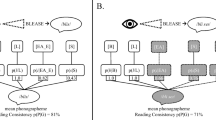Abstract
Pianists were asked to play short excerpts from several pieces on an electronic keyboard. In each piece, there were two phrases whose first few notes were played identically with the right hand. Thereafter, the two phrases were played differently. The aim of the investigation was to ascertain whether or not hand and finger kinematics diverged prior to the depression of the last common note. Such a divergence would imply an anticipatory modification of sequential movements of the hand, akin to the phenomenon of coarticulation in speech. The lack of such a divergence would imply a strictly serial organization of movement sequences with one hand, as was found previously to be the case for typing. The time at which each key was depressed and released and the speed with which the key was depressed was recorded via a MIDI interface to a laboratory computer. The motion of the right wrist and of the fingers of the right hand was recorded optoelectronically. Piano playing can invoke anticipatory modifications of hand and finger kinematics. The time at which two patterns of movements diverged varied considerably from piece to piece. Playing an ascending scale with the requirement of a “thumb-under” maneuver could evoke an anticipatory modification as much as 500 ms in advance of the last common note. In another piece, keypresses appeared to be executed in a strict serial ordering and a third piece gave results intermediate between these two extremes. We interpret the results to suggest that a strict serial execution of a movement sequence is favored as long as this is compatible with the demands of the task.
Similar content being viewed by others
References
Benguerel AP, Cowan HA (1974) Coarticulation of upper lip protrusion in French. Phonetica 30: 41–55
Daniloff R, Moll KL (1968) Coarticulation of lip rounding. J Speech Hear Res 11: 707–721
Fish J, Soechting JF (1992) Synergistic finger movements in a skilled motor task. Exp Brain Res 91: 327–334
Flanders M, Soechting JF (1992) Kinematics of typing: parallel control of the two hands. J Neurophysiol 67: 1264–1274
Gordon AM, Casabona A, Soechting JF (1994) The learning of novel finger movement sequences. J Neurophysiol 72: 1596–1610
Halsband U, Binkofski F, Camp M (1994) The role of perception of rhythmic grouping in musical performance: evidence from motor-skill development in piano playing. Music Percept 11: 265–288
Hikosaka O, Rand MK, Miyachi S, Miyashita K (1995) Learning of sequential movements in the monkey: process of learning and retention of memory. J Neurophysiol 74: 1652–1661
Hollerbach JM (1981) An oscillation theory of handwriting. Biol Cybern 39: 139–156
Kent RD, Adams SG (1989) The concept and measurement of coordination in speech disorders. In: Wallace SA (ed), Perspectives on the coordination of movement. North-Holland, New York, pp 415–450
Palmer C (1989) Mapping muscial thought to muscial performance. J Exp Psychol Hum Percept Perform 15: 331–346
Repp BH (1992) Probing the cognitive representation of musical time: structural constraints on the perception of timing perturbations. Cognition 44: 241–281
Repp BH (1994) Relational invariance of expressive microstructure across global tempo changes in music performance: an exploratory study. Psychol Res 56: 269–284
Soechting JF, Flanders M (1992) Organization of sequential typing movements. J Neurophysiol 67: 1275–1290
Soechting JF, Terzuolo CA (1987) Organization of arm movements. Motion is segmented. Neuroscience 23: 39–52
Sternberg S, Monsell S, Knoll RL, Wright CE (1978) The latency and duration of rapid movement sequences: comparisons of speech and typewriting. In: Stelmach GE (ed) Information processing in motor control and learning. Academic Press, New York, pp 118–152
Terzuolo CA, Viviani P (1980) Determinants and characteristics of motor patterns used for typing. Neuroscience 5: 1085–1103
Viviani P, Terzuolo C (1983) The organization and control of movement in handwriting and typing. In: Butterworth B (ed) Language production, vol 2. Academic Press, London, pp 103–146
Author information
Authors and Affiliations
Corresponding author
Rights and permissions
About this article
Cite this article
Engel, K.C., Flanders, M. & Soechting, J.F. Anticipatory and sequential motor control in piano playing. Exp Brain Res 113, 189–199 (1997). https://doi.org/10.1007/BF02450317
Received:
Accepted:
Issue Date:
DOI: https://doi.org/10.1007/BF02450317




